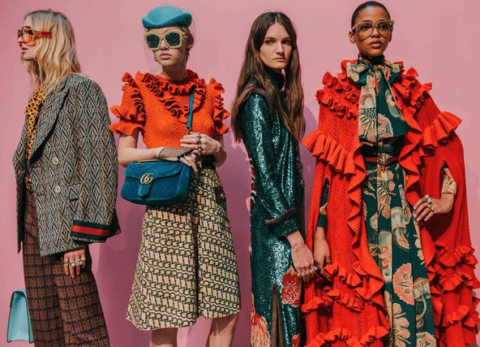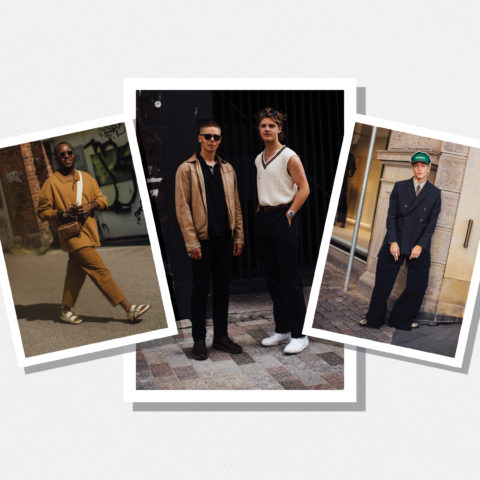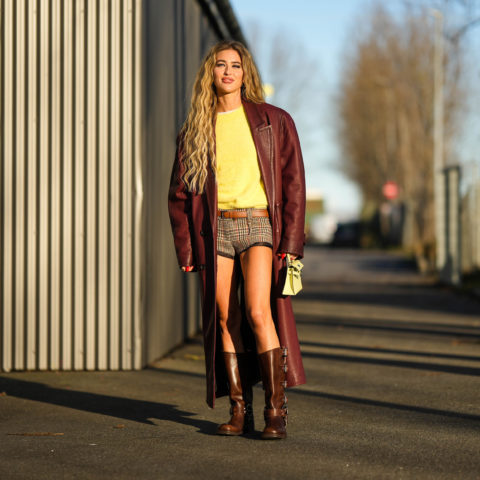Milan Fashion Week is bringing personality back to the runway

If you’ve been paying any attention to fashion month, or fashion in general over the past few years, you know that the world is divided into two camps: The cult of the uniform and the cult of personality.
Uniform dressing, first taken up by Céline and then succeeded by minimalists like The Row, Jil Sander, Calvin Klein and Lemaire, among others, is exemplified by those decidedly understated collections that don’t change much, yet so beautifully resonate with a real woman’s wardrobe. The cult of personality, however, takes almost hedonistic pleasure in the dress-up fantasy, with Gucci’s off-kilter, era-remixed vintage hounds as the most iconic (and current) example. Seriously—there hasn’t been an aesthetic more hyped and refreshing since Dior’s New Look in 1947 (Christian may have given women waists, but Alessandro Michele let their nerdy freak flags fly).
It’s no surprise then that Milan, home of Michele’s revolution, is feeling a renaissance of sorts. Over the past few years, fashion has sped up and become more visible, increasingly more about the new (a.k.a. instant show access, trends that all quickly became street style bait) and has turned designers into commodities. Yet Milan, like an old Italian patriarch, didn’t change much. While New York had the Alexander Wangs and the Prabal Gurungs and the Hood by Airs, London had the Christopher Kanes and the Mary Katrantzous, Paris had the Isabel Marants and the Vetements, Milan still staged sleepy collections by establishment names like Armani, with Prada and a handful of others being the only bright spots. The city was in need of some young blood.
The revolution quietly kicked off in Fall 2014 with Stella Jean, the Haitian-Italian designer who presented her second collection at Armani’s Teatro (the theater Giorgio reserves for his own shows). That particular show, and the the resulting buzz, cemented her as one to watch. Jean had just won Italian Vogue’s annual Who’s On Next competition, which has quickly become incredibly influential in Milan’s fashion renaissance. By publicly spotting and supporting new talent, it’s lead to a solid system for those labels to flourish within.
But it seems like what Milan has always nurtured more than young talent is the idea of the iconoclast. Miuccia Prada, who is so anti-fashion and politically and intellectually-charged that everything she puts out becomes an instant classic, had been the champion of the movement for decades (even though at times in Milan she’s been the only one). Without Prada setting the example, the Micheles and Jeans wouldn’t exist.
If you look back, Prada’s painstaking devotion to historical references blending with current movements (her recent show of ’50s hemlines and ’40s silhouettes alongside corsets made for a powerful and timely feminist statement) have set the standard for other designers. In his short tenure at Gucci, Michele has made waves by blending his own historical swipe with modern influences (his inspiration for Fall 2016 was documented on his Instagram. Follow @lallo25 immediately). This would not have been possible without Prada doing it first.
Recently, Miuccia told Vogue: “I feel more and more, as I get older, that it is my responsibility to teach.” That statement seems to resonate on so many levels now with the mini fashion revolt that’s happening in Milan. And it’s rare for an old-world fashion city to rally so strongly for the next generation.
It seems to be working: A slew of other young designers followed in Jean’s footsteps, making Milan a more welcoming place for upstart labels. Marco di Vincenzo, who was once on the design team at Fendi, launched his eponymous, rainbow-spangled line not long after. And when Michele took over Gucci, he was a totally unknown young dude.
Now, Massimo Giornetti (who is currently at the helm of Pucci), who initially made a mark with his contemporary and colourful MSGM label, is proving himself with his Pucci revamp. The collection finally seemed to hit its stride this week with the newish designer’s Fall 2016 collection (he took over for Peter Dundas last season, FYI). It was a youthful mix of alpine takes on Pucci’s classic geometric prints with some streetwear flavour, a much-needed refresher on the been-there-done-that house (seriously how many colourful caftans does one need?).
And then there’s Gucci’s continued evolution with references to both dicso swagger and renaissance royalty at the fall ‘16 show, proving that Prada’s history lessons do pay off. The use of both models and muses on the runway (Toronto-bred photographer and artist Petra Collins walked) continued to push out of the norm.
Sure, Milan is still lagging behind the current fashion conversation about staging shows and their relevancy to consumers: New York brought about the question of whether they’re even still necessary. Diane von Furstenberg, as NYC established as you get, staged her recent Fall 2016 at one of her stores, where guests could mingle and interact with models vs just sitting there and watching them walk, for example. But what Italian fashion is encouraging in the next generation of design talent is the idea of the historian, the iconoclast. Which makes sense given Italy’s own rich history with art (like, as in it basically all started there).
I mean, I’m totally playing armchair analyst here, because full disclosure: I am writing this from my cozy couch in Los Angeles instead of actually trekking through Italian streets. But doesn’t that fact drive home the idea of overexposure in fashion becoming a problem? One can analyze all they want when clothes are put on the runway, then on the internet where they can become instantly familiar, many months before they’re actually available? That’s another conversation, though, and Milan isn’t there yet.
But something is happening.







